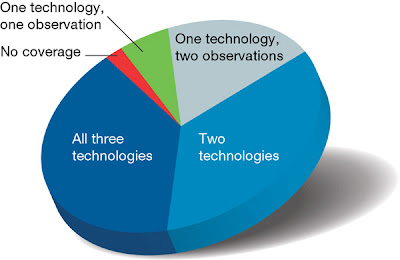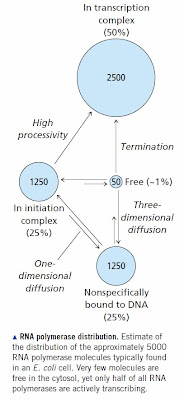RNA viruses are viruses that contain RNA instead of DNA. When the RNA molecule is injected into the cell it serves immediately as a template for translation. All RNA viruses have genes for making new viral particles and new copies of the RNA genome.
In eukaryotes, there is a large class of RNA viruses known as
retroviruses. They have an obligatory stage where the RNA is reverse transcribed into DNA and the DNA is inserted into the genome where it resides as a provirus.

The structure of the integrated retrovirus genome is shown above. The ends of the viral genome contain long terminal repeat (LTR) sequences of several hundred base pairs. Both LTRs are arranged in the same orientation and the outside ends of each are flanked by short inverted repeats. The host DNA at the site of the insertion contains a short (5- bp) repeated sequence that is produced on integration as in transposons [
Transposons: Part I].
There are three open reading frames (ORFs) in the retrovirus genome. One of these encodes a protein called gag that's involved in packaging the retroviral RNA in the virus particle. The gag protein is cleaved after translation to produce a number of individual proteins.
The
pol ORF (gene?) encodes another polyprotein that is cleaved to produce reverse transcriptase, integrase, and a protease. The key enzymes are the reverse transcriptase, which copies RNA into double-stranded DNA, and integrase, which catalyzes the insertion of retroviral DNA into the host genome.
The third ORF encodes the coat proteins of the mature viral particle.
All eukaryotic genomes contain integrated retroviruses. Some are still capable of producing new viral particles under the right conditions while others have become defective over the course of millions of years of evolution. The defective retrorvirus genomes are a kind of pseudogene. Collectively they are known as
endogenous retroviruses. [See
ERV.] About 8% of mammalian genomes consists of defective retroviruses [
What's in Your Genome?].
A common class of eukaryotic transposons is derived from retroviruses. These
retrotranspsons contain the
pol gene for reverse transcriptase and integrase and usually part of the
gag gene that encodes a protein that interacts with DNA. When the transposon is transcribed the reverse transcriptase converts the RNA into double-stranded DNA and the integrase allows it to be inserted into the genome. Like many other transposons, these retrotransposons are examples of selfish DNA whose only "function" is to propagate itself within the genome [
Transposons: Part II]. The yeast
Ty element and the
copia transposon of
Drosophila melanogaster are the classic examples of retrotransposons.

The key features of these transposons are the
pol gene and repeat sequences at the terminii. These repeats are usually called LTRs as in retroviruses but sometimes the have a different name. The yeast
Ty repeats are called δ elements. Those features are all that are necessary for these genes to propagate in the genome.
Unlike the transposons described earlier, the retrotransposons do not excise from the genome in order to jump to a new spot. Instead, the existing transposon sequence is transcribed and then a DNA copy of the transcript is re-inserted. Thus, the number of retrotransposons increases whenever a new integration occurs.
There are about 35 copies of the
Ty transposon in the genomes of most strains of yeast. In addition, there are many copies of defective transposons containing pieces of the original intact
Ty element. The typical fruit fly genome has about 100 copies of
copia and about 5000 copies of all types of retrotransposons. Many of these are defective and they contribute to a substantial percentage of the junk DNA in the
Drosophila genome.
 According to Montreal police a suspect has been arrested in the "David Mabus" case. They don't say who it was but we all know it's Dennis Markuze [Montreal police make arrest in "Mabus" case on online death threats].
According to Montreal police a suspect has been arrested in the "David Mabus" case. They don't say who it was but we all know it's Dennis Markuze [Montreal police make arrest in "Mabus" case on online death threats].

























